Learn how to create customer profiles and target your ideal consumers with practical examples, templates, and marketing strategies in this comprehensive guide.
November 17, 2023
Customer Profiles: Effective Targeting Strategies with Real-life Examples
Question
We’re trying to personalize our marketing, but our customer data is living in silos. Someone buys in-store, browses on mobile, and signs up for loyalty with a different email. Because our platforms don’t talk to each other, we still treat them like strangers—or worse, we send them a discount for the exact product they bought yesterday.
How can we unify the data to target people correctly and stop sending irrelevant messages?
Answer
You can use сustomer data platforms like Maestra to build a unified, dynamic customer profile by collecting key customer data, integrating, and cleaning that data. Then use the profile to power precise segmentation, consistent omnichannel experiences, accurate reporting, and even ML-driven next-best actions—while continuously updating profiles as new data comes in.
Now, it’s time to delve into the multitude of benefits associated with client profiles, discuss how to effectively incorporate them into your business strategy, and explore various IT solutions tailored to different company architectures.
What Is a Customer Profile?
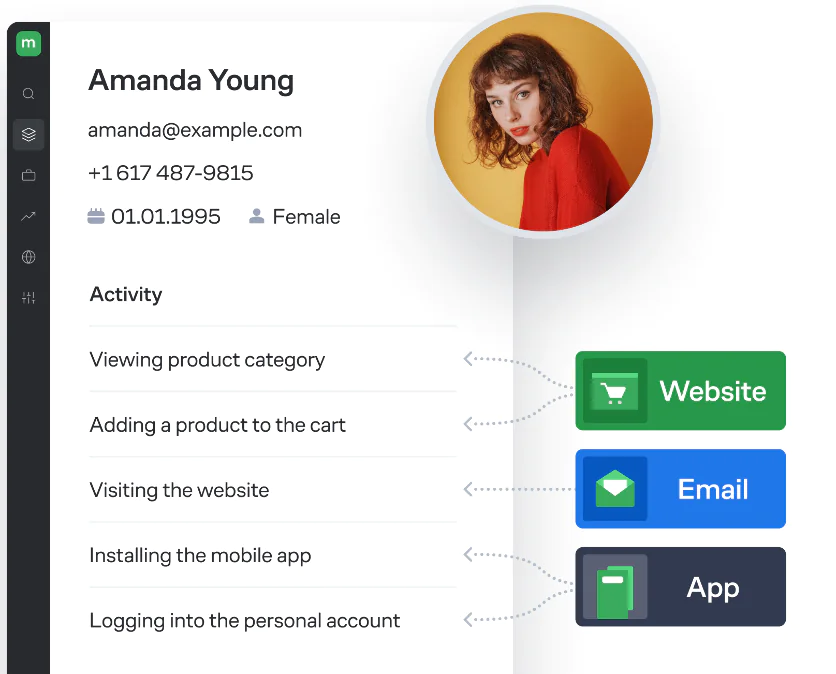
Customer data is collected from multiple sources — online and offline
A customer profile is a detailed and dynamic representation of a customer, capturing a wide range of information beyond basic details. It encompasses previous purchases, browsing habits, responses to marketing efforts, and customer feedback. This rich compilation of data paints a comprehensive picture of the customer, enabling businesses to deeply understand and connect with them on a personal level. Through these profiles, companies can tailor their offerings and communication strategies to align with each customer’s unique interests and needs. This approach not only strengthens the relationship between the customer and the brand but also ensures that the experiences provided are both relevant and valuable. Ultimately, this strategy culminates in enhanced customer satisfaction and prolonged loyalty.
Benefits of a Unified Customer Profile
Recognizing the importance of customer profiling is crucial for businesses striving to excel in today’s competitive environment. Customer profiles act as a strategic guide, offering detailed insights into customer preferences, behaviors, and purchasing history. This strategy is invaluable for personalizing offerings, ensuring that every interaction feels authentic and resonates with the individual customer. Furthermore, consumer profiles allow businesses to allocate resources more effectively, refine their strategies, and swiftly adapt to changes in the market. In essence, a customer profile is not just a beneficial addition to your marketing strategy, but a fundamental catalyst for delivering outstanding customer experiences and driving sustained growth.
Unified User Experience
Creating a seamless and consistent user experience across all channels is crucial, and a unified customer profile plays a pivotal role in achieving this. It enables customers to transition smoothly between different touchpoints, whether they are registering on a mobile app, placing an order on a website, picking up a product in-store, or participating in a loyalty program. This continuity not only enhances the customer’s experience but also strengthens their connection with the brand, leading to increased satisfaction and loyalty.
Case study.
Our client, METRO (a big box retailer), for example, uses a unified customer profile to navigate the complexities of serving customers in multiple roles. For instance, many customers may switch between any or all of the following roles:
Our client, METRO (a big box retailer), for example, uses a unified customer profile to navigate the complexities of serving customers in multiple roles. For instance, many customers may switch between any or all of the following roles:
- Regular consumer: Purchasing products for home use.
- Restaurant owner: Purchasing products for the restaurant.
- Store owner: Purchasing products for the store.
- Business owner with an office: Purchasing products for the office.
To address this, METRO assigns separate cards, phone numbers, and emails to each customer role, ensuring tailored and relevant communications and a unified experience for each role. Maestra helps the brand consolidate all customer interactions into a unified profile, enabling the retailer to send precise communications for café purchases, store supplies, and personal items to the right channels. This streamlined approach enhances customer experience while ensuring effective communication across all customer personas.
Data Integrity
Maintaining data integrity is crucial, as it extends beyond ensuring accurate and personalized customer interactions; it has the potential to influence and reshape strategic business directions. A compelling example is a case involving one of our clients managing two brand databases. Initial market research suggested a mere 2% customer overlap between the brands. However, after merging the databases and employing advanced deduplication algorithms, a significant 40% overlap was revealed. This insight highlighted the brands' unintentional competition and led to a substantial shift in communication strategies, underscoring the transformative power of accurate data.
Precise Targeting
By developing a unified customer profile, businesses can target their audience more precisely, leading to more personalized website experiences and effective audience segmentation, while also helping to avoid overwhelming the customer with excessive communication. For instance, if a customer has already interacted with a mobile push notification, bombarding them with additional emails or SMS messages becomes redundant and potentially irritating. By consolidating online and offline data, a unified profile also enables businesses to incorporate purchase history from physical stores, ensuring that every customer interaction is informed and relevant.
Case study.
For example, PuffCuff, one of Maestra’s clients, leveraged a unified customerprofile to significantly improve their Facebook advertising campaigns. By utilizing the comprehensive customer data in their CDP, they created a specialized segment comprising active customers — those who had recently visited the site, made purchases, and interacted with email campaigns.
For example, PuffCuff, one of Maestra’s clients, leveraged a unified customerprofile to significantly improve their Facebook advertising campaigns. By utilizing the comprehensive customer data in their CDP, they created a specialized segment comprising active customers — those who had recently visited the site, made purchases, and interacted with email campaigns.
This segment, crafted with the help of data from a unified customer profile, was then used in Facebook Ad Manager to identify and target similar potential consumers. By leveraging automatic segment updates in Maestra, PuffCuff ensured their audience for lookalike campaigns remained precise and current, reflecting recent customer interactions and engagements.
The results were striking, with a 63.96% reduction in CPM (Cost Per Mille) and a 43.76% decrease in the cost per order.
Unified Reporting
When customer communication data is dispersed across various channels and housed in different systems, creating a cohesive report that accurately reflects all revenue becomes a daunting task. Additionally, attributing sales to specific channels can become exceedingly complex. Employing a unified customer profile provides a precise and comprehensive view of the customer’s journey, illuminating the interactions that led to a purchase.
Absence of such a unified profile complicates the task of performing meaningful analyses and tracking conversion trends. This challenge is exacerbated when initial interactions are recorded in one system, while the final, crucial action — such as a purchase — is logged in another, such as an operational CRM, isolated from marketing data.
Machine learning
As the efficacy of traditional growth strategies plateaus, machine learning emerges as a powerful tool to harness the full potential of accumulated data. Whether it’s recommending products, predicting customer churn, or forecasting future purchases, machine learning requires a rich set of clean data — a requirement fulfilled by a unified client profile. Attempting to amalgamate data from disparate sources can be costly, time-consuming, and ultimately, less effective. Hence, unified customer profiles are indispensable for reaping the full benefits of machine learning, ensuring accurate models and more informed business decisions.
Case study.
Maestra’s client, Beethoven (a pet store chain), faced a common retail challenge: predicting when customers need to replenish items such as pet food and litter. To address this, Beethoven implemented a Next Best Action (NBA) machine learning algorithm, analyzing purchase history and email interactions from their unified customer profiles.
Maestra’s client, Beethoven (a pet store chain), faced a common retail challenge: predicting when customers need to replenish items such as pet food and litter. To address this, Beethoven implemented a Next Best Action (NBA) machine learning algorithm, analyzing purchase history and email interactions from their unified customer profiles.
This approach aimed to determine the most effective timing for sending personalized product recommendations. The emails, featuring a list of previously purchased items and a “Repeat My Previous Order” button, were designed to simplify the repurchasing process. To evaluate the effectiveness of this strategy, Beethoven conducted an A/B test, comparing the NBA algorithm’s recommendations with emails sent based on average purchase intervals. The results, significant at a 95% confidence level, suggested that integrating machine learning with customer profiles can offer a more nuanced approach to customer communication compared to traditional methods.
Types of Customer Profile Data
Understanding the various dimensions through which customer data can be segmented is crucial for building a comprehensive customer profile — use the features below as an example of the types of data you can collect and use.
Demographic
Demographic profiling dives deep into the core aspects of your customers' identities. This segmentation method categorizes customers based on personal characteristics such as:
- Age
- Gender
- Income
- Ethnicity
- Marital status
- Education
- Job title
Behavioral
Behavioral profiling offers insights into how your customers engage with your brand and what influences their purchase decisions. This segmentation method clusters customers based on behavioral tendencies, encompassing:
- Brand engagement
- Purchase history and spending habits
- Product/service usage patterns
- Level of attention required
Psychographic
While capturing psychographic data can be challenging due to its subjective nature, it is among the most potent information within a customer profile. It provides profound insights into the thought processes driving purchases and how customers feel about your brand. This data covers things such as:
- Habits
- Interests
- Lifestyle choices
- Personality traits
- Core values and beliefs
- Aspirations and goals
- Pain points and challenges
- Religious beliefs
- Political affiliations
Geographic
Geographic profiling pinpoints your customers based on their physical location and where they prefer to shop, segmenting customers based on characteristics like:
- Where they live — including city, town, neighborhood, region, country
- Language
- Cultural background
- Workplace location
Leveraging these diverse data types enables businesses to tailor their marketing and communication strategies effectively. Through careful analysis, companies can craft personalized messages, identify the most effective communication channels for different customer segments, uncover opportunities for upselling and cross-selling, and ultimately enhance the overall customer experience.
Strategies for Unifying Customer Data in Different Business Settings
The technical necessities for developing a unified customer profile are contingent upon the scale and intricacy of your business operations. If you run a small, local business, for instance, you can often manually manage a customer database in Google Sheets at no cost. However, the larger the company’s scale, the more IT systems are engaged in its operations, and the more challenging it becomes to integrate them. Let’s explore three potential scenarios to understand this better.
The first scenario occurs when a company has multiple IT systems that are integrated, such as a backend ERP and a website management system. In this case, a unified customer identifier is most likely utilized by default.

The second scenario presents itself when several IT systems operate independently of each other, such as a backend ERP and a custom-built CRM. To create a unified customer profile in this case, IT specialists are required to integrate these disparate systems. This integration could involve establishing a new, unified customer identifier or selecting a "master system" to process data from different systems and lead the integration process.
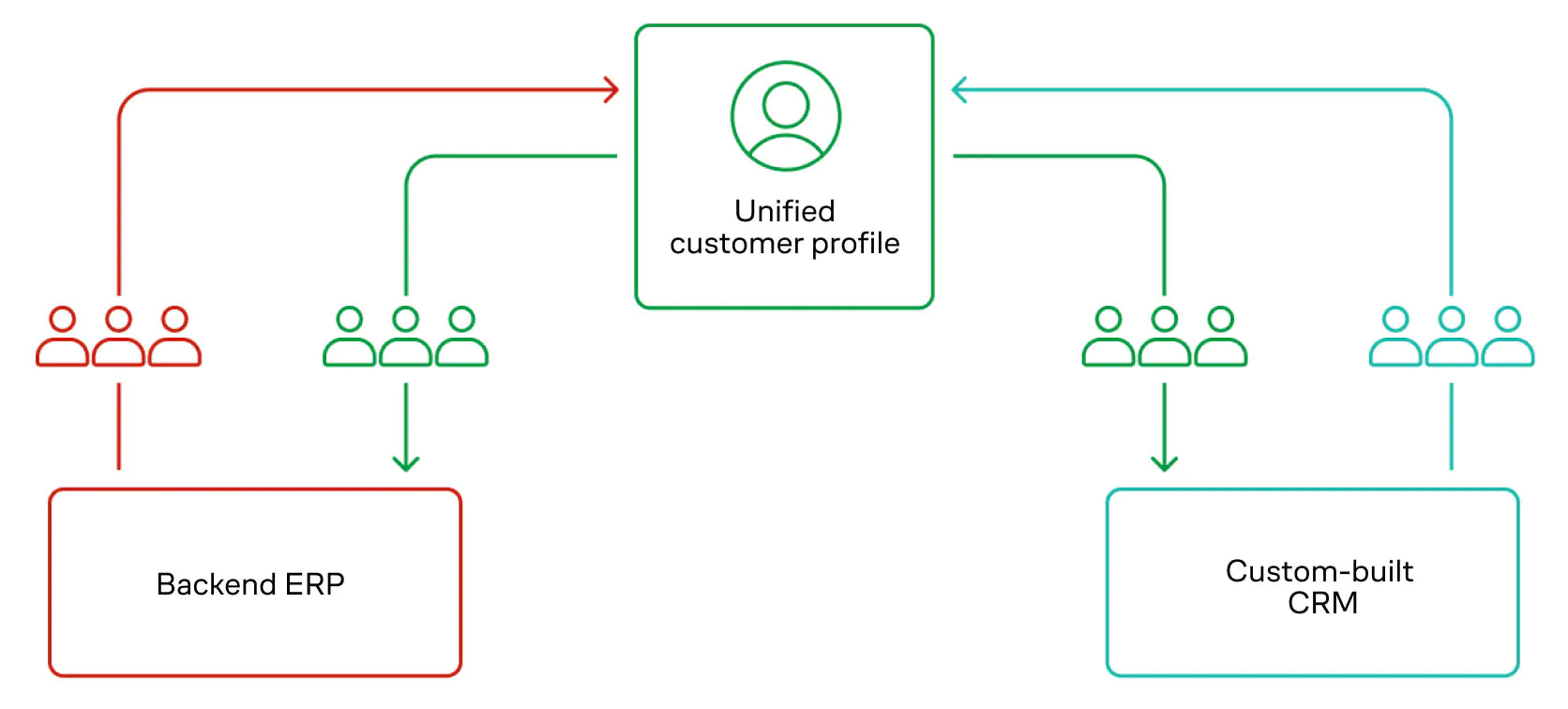
The third scenario tends to be the most common. Here, numerous IT systems operate in silos. Here, there are two architectural approaches to consider:
1. Building business operations around a unified customer profile from the start. This architecture entails a master system at the core, complete with a customer identifier, to which all other IT systems connect in real time. This method ensures optimal data quality but typically involves higher implementation costs.
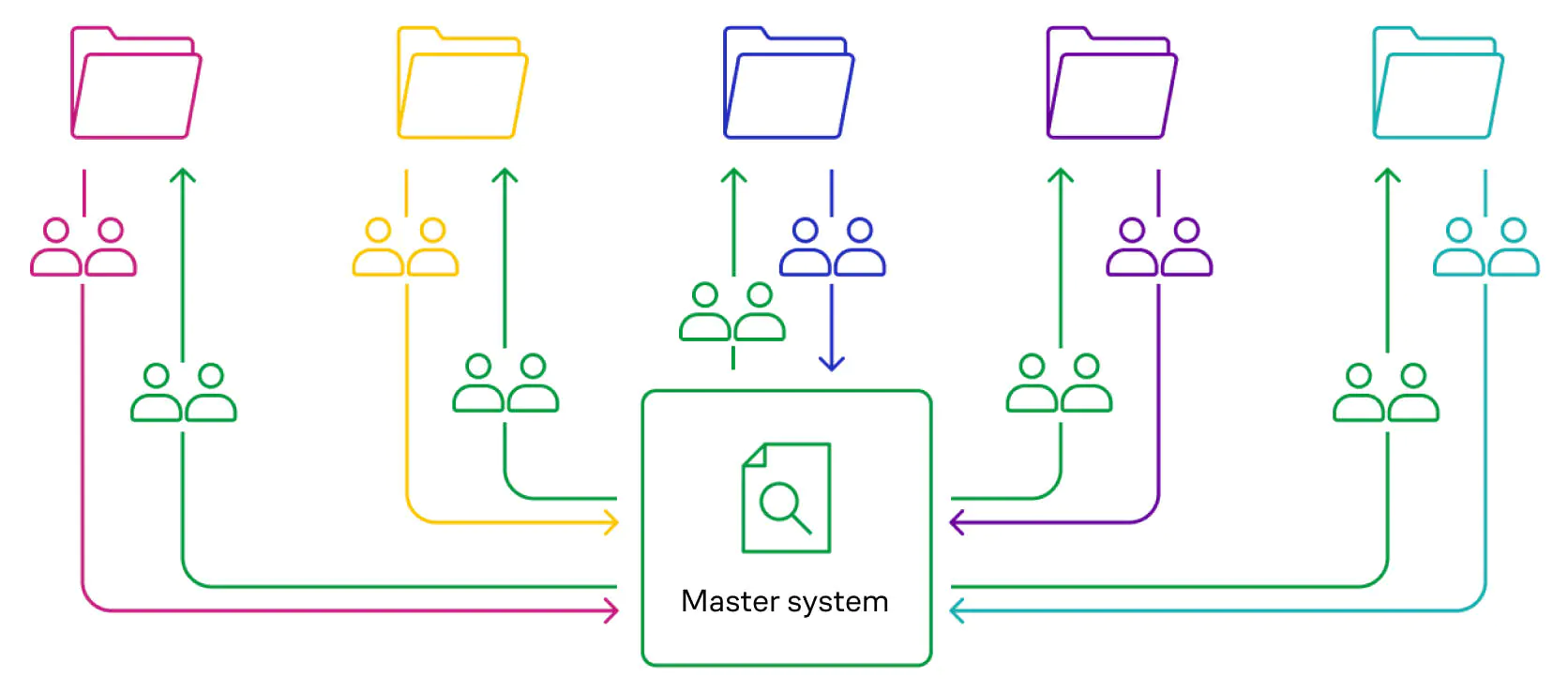
2. In the second structure, different business processes such as sales, customer acquisition, retention, and inventory management operate on separate IT systems. In these cases, tools like Maestra can be used to unify these systems by gathering, integrating, and cleaning the data from each system to create a single customer profile for marketing purposes. This approach is generally quicker to implement, but some data loss is inevitable during integration.
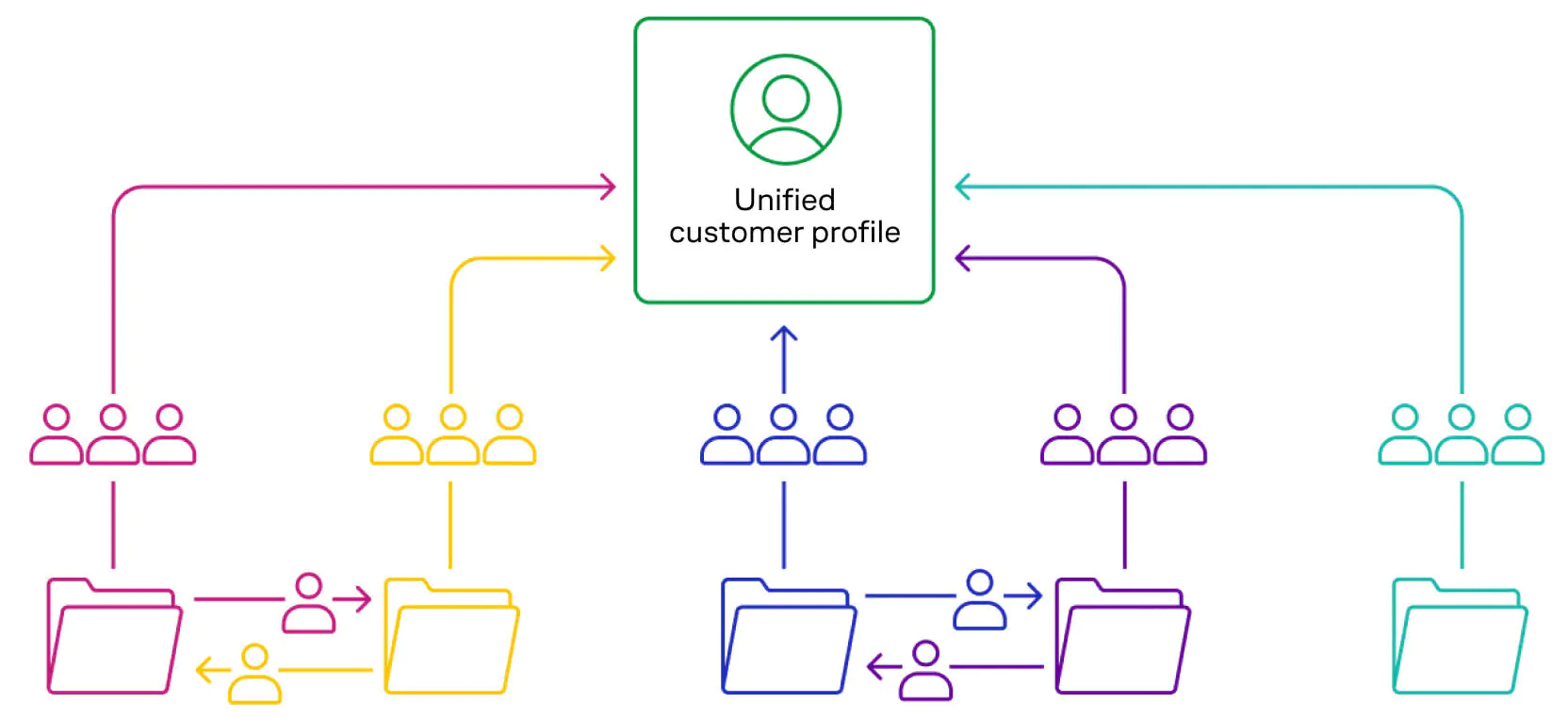
The cost and implementation timeline for these solutions are primarily determined by the integration efforts required. This, in turn, depends on the number of systems in play and the volume of customer data — larger datasets exponentially increase the complexity of integration.
In practice, businesses often start with a "side integration," using the unified profile for specific functions while maintaining existing systems. As confidence in the unified profile grows and data quality improves, more systems may gradually transition to using it as the master data source, evolving from the decentralized approach to a more centralized architecture.
How to Create Customer Profiles: A Step-by-Step Guide
1. Data Collection: Begin by gathering a comprehensive set of data on your customers. This should include demographic information (age, gender, income, etc.), behavioral data (purchase history, product preferences, engagement with your brand), psychographic details (interests, values, lifestyle), and geographic location.
2. Data Integration: Use customer profile software (such as Maestra) to consolidate data from various sources, ensuring consistency and completeness. This step is crucial for creating a unified view of each customer.
3.Data Analysis: Analyze the integrated data to uncover patterns, preferences, and behaviors.
4. Segmentation: Divide your customer base into distinct segments based on common characteristics or behaviors identified during the analysis. Each segment should represent a unique customer persona.
5. Profile Creation: For each segment, create a detailed customer profile that outlines key characteristics, preferences, and behaviors. Ensure that these profiles are comprehensive and specific, capturing the essence of each customer segment.
6. Application: Utilize the insights gained from the customer profiles to tailor your products, services, and marketing strategies. Ensure that your communication is personalized and relevant to each customer segment.
7. Evaluation and Update: Regularly evaluate the effectiveness of your strategies and update the consumer profiles as needed. Pay attention to changes in customer behavior and preferences, and adjust your strategies accordingly to maintain relevance and effectiveness.
8. Feedback Loop: Establish a feedback loop to continuously gather data on customer interactions and satisfaction. Incorporate this feedback into your business operations, using it to continuously refine each customer profile and inform your strategic plan.
By following these steps, you will be able to create detailed and effective customer profiles, leading to enhanced customer experiences, increased loyalty, and business growth.
Customer Profile Example
Building a detailed customer profile is essential for tailoring your offers and communications to the right audience. While the exact components of your customer profile template might differ based on your business’s specific needs, having a foundational structure can be beneficial. The example below demonstrates a customer profile that a shoe brand may potentially have:
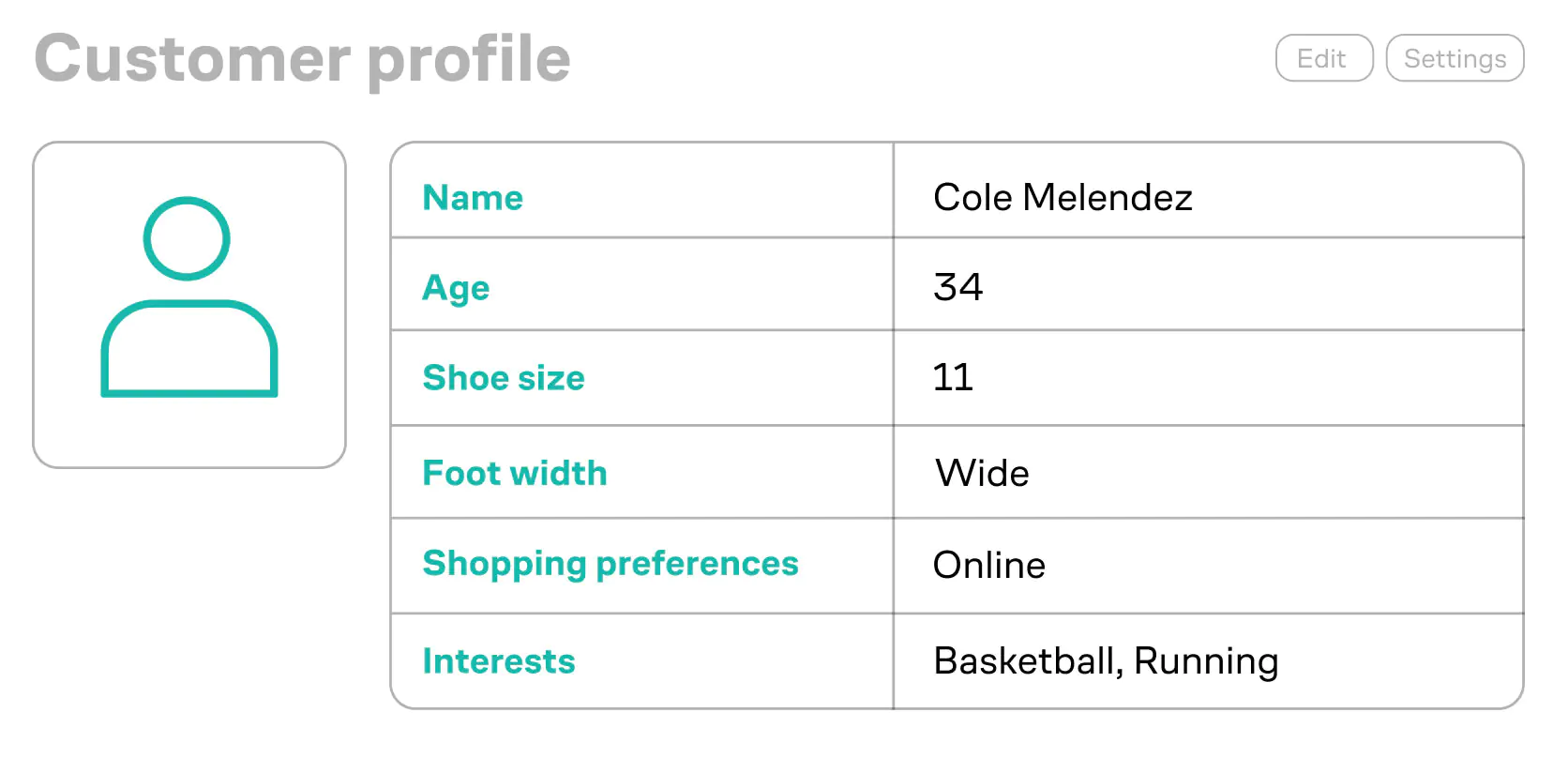
An example of a simple customer profile
With the details listed in this customer’s profile, the shoe retailer can deeply understand and cater to this individual’s specific needs. By knowing Cole’s shoe size, the brand can send him precise shoe recommendations that match available inventory. His foot width and athletic interests further refine these suggestions, ensuring he receives options aligned with his basketball and running pursuits, rather than irrelevant offerings like size 9 soccer boots. Additionally, recognizing Cole’s preference for online shopping empowers the brand to optimize their digital marketing strategies, emphasizing online campaigns and advertisements. For customers who favor in-store experiences, the focus would shift towards strategies encouraging in-store visits.
Conclusion
Today’s customers are not just looking for products; they seek experiences, authenticity, and a genuine connection with the brands they choose to engage with. At the crux of this dynamic lies a conundrum many businesses grapple with: How can we truly understand our customers?
One solution is the creation and effective use of comprehensive customer profiles. Creating a unified customer profile allows for consolidated reporting, precise targeting, a consistent user experience across all channels, data cleansing, and the application of machine learning. Such an approach doesn’t just enhance customer satisfaction. It paves the way for improved resource allocation, a deeper bond with the customer, and the agility to adapt to ever-evolving market trends.
To compile customer data into a single profile, a comprehensive customer identifier is required, ensuring data consistency across all business facets. It’s imperative that all of the company’s IT systems are either directly integrated with each other or connected via a unifying system. Furthermore, it’s essential to enrich customer data as needed, allowing for the testing and validation of hypotheses. This strategic approach ensures that businesses can leverage customer information effectively, paving the way for more personalized and impactful customer interactions.


